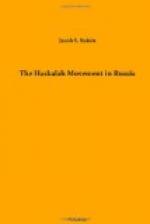This short period of enlightenment and tolerance, inaugurated by a semblance of equality, indicates the native optimism of the Slavonic Jew. For a while a cessation of hostilities was evident in the camp of Israel. The reforms introduced by the Gaon, and propagated by his disciples, began to bear fruit. Hasidism itself underwent a radical change under the leadership of Rabbi Shneor Zalman of Ladi (1747-1813) and Jacob Joseph of Polonnoy, who, unlike their colleagues of the Ukraine, were learned in the Talmud and familiar with the sciences. Protests by Hasidim themselves against the irreverent spirit that developed after the death of the Besht, had in fact been heard before. The saintly and retiring Abraham Malak (d. 1780) had denounced, in no uncertain terms, the gross conception held by the Hasidim of the sublime teachings of their own sect. He drew a beautiful picture of the ideal zaddik, who is “so absorbed in meditation on the Divine wisdom that he cannot descend to the lower steps upon which ordinary people stand."[16] But the more active Rabbi Shneor, or Zalman Ladier, as he was usually called, insisted on putting the zaddik on a par with the rabbi, whose duty it is not to work miracles but to teach righteousness. Assuming for his followers the name HaBaD, the three letters of which are the initials of the Hebrew words for Wisdom, Reason, and Knowledge, he furthered the cause of enlightenment in the only way possible among his adherents.[17] How well he succeeded may be inferred from the fact, trivial though it be, that the biography of the Besht, The Praises of the Besht (Shibhe ha-Besht), by Dob Baer, published in Berdichev (1815), omits many of the legends about the Master included in the version published the same year in Kopys. The omission can be explained only on the ground that the editor, Judah Loeb, who was the son of the author, did not wish to give offence, or he had outgrown the credulity of his father.[18]




